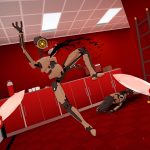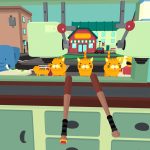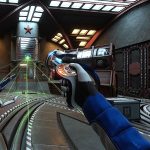Revisiting the world of Budget Cuts in Budget Cuts Ultimate from Neat Corporation on PSVR2! This brings together Budget Cuts 1 & 2 along with some quality of life improvements and is the first time Budget Cuts 2 has been available on PlayStation.
Budget Cuts Ultimate from Neat Corporation brings the stealthy, robot-dodging thrills of the first game and its sequel to PSVR2 for the first time, but is it worth bringing home or is it best left in the office? Let’s find out.
First up thanks to the developer for providing me with a review key for the game but as always the opinions presented here are entirely my own.
The first Budget Cuts came out in 2020 on the original PSVR. Back then I enjoyed its combination of humour and stealth gameplay and always felt a bit disappointed that we never got a port of the sequel. Fast forward to 2023 and this Ultimate edition brings both games together in one package, with this being the sequel’s first outing on PlayStation.
The storyline sees you as possibly the last human worker at robot manufacturer TransCorp, with all your fellow humans having seemingly vanished leaving only your robot co-workers in the office. A mysterious voice over the phone suggests that you may be next to go and recommends making a swift exit, and here begins your adventure.
Gameplay is essentially a mix of stealth, combat and puzzle solving as you navigate your way round the offices of TransCorp, and later other environments, whilst also discovering more about what’s going on. Along the way you’re ably assisted by further phone calls and faxes from the person who first contacted you, offering advice on what to do and where to go next. Stealth is the preferred approach, ducking behind cover, sneaking through wall vents and ceiling cavities, and rifling through drawers to find security passes to get you through that next locked door.
To help you get around you have a gun-like device called a TransLocator. This device enables you to fire off a small ball of energy which then acts as a kind of portal which you can look through to check the surroundings ahead before teleporting to the spot where it landed. This might seem like an excuse to only include teleport locomotion but is actually quite a unique gameplay device and enables you to get into all kinds of awkward, otherwise inaccessible, locations. Since the original game launched the developer has added an option for smooth locomotion, but even with that enabled you’ll still find yourself using the TransLocator device to reach certain places. You also have a couple of other tools at your disposal which can be hot-swapped at any time. One enables you to pick up and interact with objects, the other allows you to tag enemies so that you can then keep track of their positions even when they’re obscured by the environment.
The worker robots that you frequently bump into are friendly enough and don’t pose a threat, in fact they make idle chit-chat and will even give you a little wave back if you wave at them. However, you will need to be on the lookout for supervisor and prosecutor bots who are not so friendly and will try their best to terminate your employment in a very literal sense if they discover you.
In the event that you are discovered, or if you just prefer the direct approach, you can engage in combat using a variety of found objects. This ranges from coffee cups, surprisingly effective when thrown with enough force, through to the totally innocent letter openers which are most definitely not knives. Hitting your target with one of these often results in a particularly messy, and strangely disturbing, amount of oil splatter, leaving the place looking like a not so subtle crime scene.
Towards the midpoint, originally the end section of the first game, you’ll get to meet Adam from HR who, for a game that starts off quite light-heartedly, is actually quite terrifying and launches you into an intense game of cat and mouse.
A nice bit of work has been done to update the ending of Budget Cuts so that it seamlessly transitions into Budget Cuts 2, effectively making it one longer game consisting of 13 levels. One downside of this, unless I missed something, is that you can’t hop straight into Budget Cuts 2 from the start, so even if you’ve already completed Budget Cuts you’re going to have to play through it all again to get into the sequel.
The Budget Cuts 2 levels mix things up from the office cubicles of Budget Cuts and bring some variety to the environments and gameplay, with a great start sequence aboard a train. Along with some new characters, friendly and not so friendly, it also includes the return of an old enemy from HR. The combat becomes a little more serious with the introduction of a real, actual weapon, although there are still plenty of coffee cups to be thrown around if you find yourself in a tight spot.
There are fairly regular automatic save points dotted throughout, so if you meet a sticky end or need to switch off you’re never too far from where you left off. From the main menu you can also jump directly into any level you’ve previously completed.
As an extra side-quest, dotted throughout the game there are several collectible items to be discovered. Once you find these they appear in the main menu hideout, which you can walk around at your leisure and which becomes more populated with scenery and features the more you play the main game. The hideout is also where you’ll find the Budget Cuts Arcade cabinet, which offers 5 shorter, objective-based levels which you can replay for high scores.
Graphically the game looks, unsurprisingly, like a first generation PSVR game. The graphic style is simplistic and clean with some good looking character models and animations for your robot friends and enemies. Possibly emphasised by the fact I’d just finished playing Red Matter 2 with its super-sharp graphics, the image quality here is kind of blurry and on the soft side. For the first hour or so I couldn’t help but wish it was a bit sharper but then the more I got back into the game the less I thought about it. To be fair, the developer makes no claims to have upscaled or improved the graphics in any way but I still wonder what it might have looked like with a resolution upgrade. There are occasionally a few judders and some pop-in when objects or scenery render in at the periphery of your vision but on the whole the visuals are serviceable and still exude a certain charm in the characters and environments.
Audio is very good with a lot of funny comments from the robots and office P.A. system, and good voice acting all around for both human and robot characters. There’s some nice context sensitive music woven into the game as well, with some dramatic moments during the more intense stealth sections. I was a bit sad that, slightly ironically, the faster loading times of the PS5 mean that you don’t get to hear quite so much of the loading screen music as that was one of my favourite pieces in the original PS4 version! The volume levels do seem to be a bit all over the place, with sometimes overwhelming amounts of sound and chatter all playing simultaneously and distance from sound sources becoming irrelevant, although this was perhaps done to ensure you don’t miss important bits of dialogue when wandering too far from the source.
Controls are pretty straightforward using both Sense controllers. As mentioned, the teleport mechanic is an integral part of the game and required for reaching certain areas but you can optionally enable smooth locomotion for walking around, or stick entirely to teleportation if you prefer. You can also opt for click turning or smooth turning. Unfortunately there’s no crouch button so you need to physically crouch to hide behind things, making seated play a bit awkward, but there is an auto-crouch option which will automatically duck down whenever you teleport underneath a low ceiling or into a small space. The various tools at your disposal can be equipped into either hand, so you can use whichever dominant hand you prefer.
From the menu it’s possible to toggle various cheats, previously known as mutators. These add some variety to the gameplay by changing things such as enemy abilities, gravity effects and weapons and, although I won’t spoil them by going into details, they can make quite a difference to the gameplay, which is great if you’re going back for multiple playthroughs.
Overall I really enjoyed dipping back into the world of Budget Cuts and was pleased to finally get to experience and play through the sequel. Although it’s showing its age a bit these days it remains a lot of fun to play and is well written with a lot of great humour. The stealth gameplay is still quite unique among PSVR games and despite the lighter tone is actually one of the closest things to a Metal Gear Solid style of gameplay that we’ve had on the system so far. With the two games seamlessly joined together now there’s a good 10+ hours of gameplay here, with a certain amount of replayability both in the main game, which you could potentially play through in a few different ways/styles, and in the Arcade for score/time chasing. The asking price is a very reasonable £22, especially good if you don’t already own the first game. So if you’re ok with the slightly dated graphics and enjoy a bit of stealth gameplay, or if you played the original and are curious about the sequel, then I can absolutely recommend picking this up.





